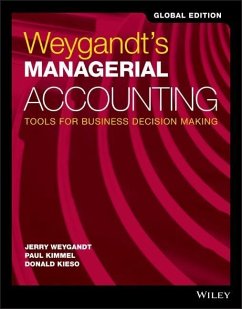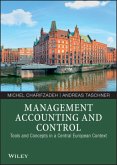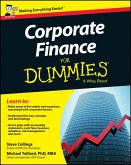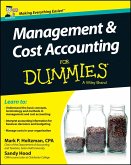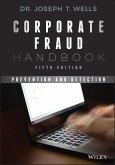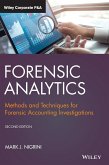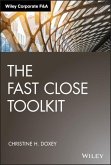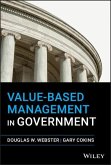Jerry J. Weygandt, Paul D. Kimmel, Donald E. Kieso
Weygandt's Managerial Accounting
Tools for Business Decision Making, Global Edition
Jerry J. Weygandt, Paul D. Kimmel, Donald E. Kieso
Weygandt's Managerial Accounting
Tools for Business Decision Making, Global Edition
- Broschiertes Buch
- Merkliste
- Auf die Merkliste
- Bewerten Bewerten
- Teilen
- Produkt teilen
- Produkterinnerung
- Produkterinnerung
Weygandt's Managerial Accounting provides students with a clear introduction to fundamental managerial accounting concepts. This edition helps students get the most out of their accounting course by making practice simple. Designed for a one-semester, undergraduate Managerial Accounting course, the authors provide new opportunities for self-guided practice allowing students to check their knowledge of accounting concepts, skills, and problem solving techniques and receive personalized feedback at the question, learning objective, and course level.
Newly streamlined learning objectives help…mehr
Andere Kunden interessierten sich auch für
![Management Accounting and Control Management Accounting and Control]() Michel CharifzadehManagement Accounting and Control39,99 €
Michel CharifzadehManagement Accounting and Control39,99 €![Corporate Finance For Dummies - UK Corporate Finance For Dummies - UK]() Steven CollingsCorporate Finance For Dummies - UK25,99 €
Steven CollingsCorporate Finance For Dummies - UK25,99 €![Management and Cost Accounting For Dummies - UK Management and Cost Accounting For Dummies - UK]() Mark P. HoltzmanManagement and Cost Accounting For Dummies - UK26,99 €
Mark P. HoltzmanManagement and Cost Accounting For Dummies - UK26,99 €![Corporate Fraud Handbook Corporate Fraud Handbook]() Joseph T. WellsCorporate Fraud Handbook110,99 €
Joseph T. WellsCorporate Fraud Handbook110,99 €![Forensic Analytics Forensic Analytics]() Mark J. NigriniForensic Analytics106,99 €
Mark J. NigriniForensic Analytics106,99 €![The Fast Close Toolkit The Fast Close Toolkit]() Christine H. DoxeyThe Fast Close Toolkit72,99 €
Christine H. DoxeyThe Fast Close Toolkit72,99 €![Value-Based Management in Government Value-Based Management in Government]() Douglas W. WebsterValue-Based Management in Government72,99 €
Douglas W. WebsterValue-Based Management in Government72,99 €-
-
-
Weygandt's Managerial Accounting provides students with a clear introduction to fundamental managerial accounting concepts. This edition helps students get the most out of their accounting course by making practice simple. Designed for a one-semester, undergraduate Managerial Accounting course, the authors provide new opportunities for self-guided practice allowing students to check their knowledge of accounting concepts, skills, and problem solving techniques and receive personalized feedback at the question, learning objective, and course level.
Newly streamlined learning objectives help students use their study time efficiently by creating clear connections between the reading and video content, and the practice, homework, and assessment questions.
Using metric units and companies with a more global feel, this new text is ideal for courses across the world.
Newly streamlined learning objectives help students use their study time efficiently by creating clear connections between the reading and video content, and the practice, homework, and assessment questions.
Using metric units and companies with a more global feel, this new text is ideal for courses across the world.
Produktdetails
- Produktdetails
- Verlag: Wiley / Wiley & Sons
- Artikelnr. des Verlages: 1W119419650
- 1. Auflage
- Seitenzahl: 688
- Erscheinungstermin: 24. Oktober 2017
- Englisch
- Abmessung: 277mm x 217mm x 25mm
- Gewicht: 1476g
- ISBN-13: 9781119419655
- ISBN-10: 1119419654
- Artikelnr.: 50160187
- Herstellerkennzeichnung
- Wiley John + Sons
- Southern Gate, Chichester
- P019 8SQ West Sussex, GB
- 0130 815199
- Verlag: Wiley / Wiley & Sons
- Artikelnr. des Verlages: 1W119419650
- 1. Auflage
- Seitenzahl: 688
- Erscheinungstermin: 24. Oktober 2017
- Englisch
- Abmessung: 277mm x 217mm x 25mm
- Gewicht: 1476g
- ISBN-13: 9781119419655
- ISBN-10: 1119419654
- Artikelnr.: 50160187
- Herstellerkennzeichnung
- Wiley John + Sons
- Southern Gate, Chichester
- P019 8SQ West Sussex, GB
- 0130 815199
1 Managerial Accounting 1-1
Just Add Water and Paddle: Current Designs 1-1
Managerial Accounting Basics 1-2
Comparing Managerial and Financial Accounting 1-3
Management Functions 1-4
Organizational Structure 1-5
Managerial Cost Concepts 1-7
Manufacturing Costs 1-7
Product Versus Period Costs 1-8
Illustration of Cost Concepts 1-9
Manufacturer Financial Statements 1-11
Income Statement 1-11
Cost of Goods Manufactured 1-12
Cost of Goods Manufactured Schedule 1-12
Statement of Financial Position 1-13
Managerial Accounting Trends 1-15
Service Industries 1-15
Focus on the Value Chain 1-16
Balanced Scorecard 1-17
Business Ethics 1-17
Company Social Responsibility 1-18
2 Job Order Costing 2-1
Profiting from the Silver Screen: Disney 2-1
Cost Accounting Systems 2-2
Process Cost System 2-3
Job Order Cost System 2-3
Job Order Cost Flow 2-4
Accumulating Manufacturing Costs 2-5
Job Cost Sheets and Manufacturing Costs 2-7
Raw Materials Costs 2-7
Factory Labor Costs 2-9
Predetermined Overhead Rates 2-12
Completed and Sold Manufacturing and
Service Jobs 2-14
Assigning Costs to Finished Goods 2-14
Assigning Costs to Cost of Goods Sold 2-15
Summary of Job Order Cost Flows 2-16
Job Order Costing for Service Companies 2-17
Advantages and Disadvantages of Job
Order Costing 2-18
Applied Manufacturing Overhead 2-19
Under- or Over applied Manufacturing Overhead 2-20
3 Process Costing 3-1
Famed Soft Drink in the Outback: Back o' Bourke Cordials 3-1
Overview of Process Cost Systems 3-2
Uses of Process Cost Systems 3-2
Process Costing for Service Companies 3-3
Similarities and Differences Between Job Order Cost and Process Cost Systems 3-4
Recording Costs 3-5
Process Cost Flow 3-5
Assigning Manufacturing Costs--Journal Entries 3-6
Equivalent Units 3-9
Weighted-Average Method 3-9
Refinements on the Weighted-Average Method 3-10
The Production Cost Report 3-12
Compute the Physical Unit Flow (Step 1) 3-13
Compute the Equivalent Units of
Production (Step 2) 3-13
Compute Unit Production Costs (Step 3) 3-14
Prepare a Cost Reconciliation Schedule (Step 4) 3-14
Preparing the Production Cost Report 3-15
Costing Systems--Final Comments 3-15
Appendix 3A: FIFO Method for Computing Equivalent Units 3-19
Equivalent Units Under FIFO 3-19
Comprehensive Example 3-20
FIFO and Weighted-Average 3-25
4 Activity-Based Costing 4-1
Wellness for Customers and the Company: Technogym SpA 4-1
Traditional vs. Activity-Based Costing 4-3
Traditional Costing Systems 4-3
Illustration of a Traditional Costing System 4-3
The Need for a New Approach 4-4
Activity-Based Costing 4-4
ABC and Manufacturers 4-7
Identify and Classify Activities and Assign Overhead to Cost Pools (Step 1) 4-7
Identify Cost Drivers (Step 2) 4-8
Compute Activity-Based Overhead Rates (Step 3) 4-8
Allocate Overhead Costs to Products (Step 4) 4-8
Comparing Unit Costs 4-9
ABC Benefits and Limitations 4-12
The Advantage of Multiple Cost Pools 4-12
The Advantage of Enhanced Cost Control 4-1
Just Add Water and Paddle: Current Designs 1-1
Managerial Accounting Basics 1-2
Comparing Managerial and Financial Accounting 1-3
Management Functions 1-4
Organizational Structure 1-5
Managerial Cost Concepts 1-7
Manufacturing Costs 1-7
Product Versus Period Costs 1-8
Illustration of Cost Concepts 1-9
Manufacturer Financial Statements 1-11
Income Statement 1-11
Cost of Goods Manufactured 1-12
Cost of Goods Manufactured Schedule 1-12
Statement of Financial Position 1-13
Managerial Accounting Trends 1-15
Service Industries 1-15
Focus on the Value Chain 1-16
Balanced Scorecard 1-17
Business Ethics 1-17
Company Social Responsibility 1-18
2 Job Order Costing 2-1
Profiting from the Silver Screen: Disney 2-1
Cost Accounting Systems 2-2
Process Cost System 2-3
Job Order Cost System 2-3
Job Order Cost Flow 2-4
Accumulating Manufacturing Costs 2-5
Job Cost Sheets and Manufacturing Costs 2-7
Raw Materials Costs 2-7
Factory Labor Costs 2-9
Predetermined Overhead Rates 2-12
Completed and Sold Manufacturing and
Service Jobs 2-14
Assigning Costs to Finished Goods 2-14
Assigning Costs to Cost of Goods Sold 2-15
Summary of Job Order Cost Flows 2-16
Job Order Costing for Service Companies 2-17
Advantages and Disadvantages of Job
Order Costing 2-18
Applied Manufacturing Overhead 2-19
Under- or Over applied Manufacturing Overhead 2-20
3 Process Costing 3-1
Famed Soft Drink in the Outback: Back o' Bourke Cordials 3-1
Overview of Process Cost Systems 3-2
Uses of Process Cost Systems 3-2
Process Costing for Service Companies 3-3
Similarities and Differences Between Job Order Cost and Process Cost Systems 3-4
Recording Costs 3-5
Process Cost Flow 3-5
Assigning Manufacturing Costs--Journal Entries 3-6
Equivalent Units 3-9
Weighted-Average Method 3-9
Refinements on the Weighted-Average Method 3-10
The Production Cost Report 3-12
Compute the Physical Unit Flow (Step 1) 3-13
Compute the Equivalent Units of
Production (Step 2) 3-13
Compute Unit Production Costs (Step 3) 3-14
Prepare a Cost Reconciliation Schedule (Step 4) 3-14
Preparing the Production Cost Report 3-15
Costing Systems--Final Comments 3-15
Appendix 3A: FIFO Method for Computing Equivalent Units 3-19
Equivalent Units Under FIFO 3-19
Comprehensive Example 3-20
FIFO and Weighted-Average 3-25
4 Activity-Based Costing 4-1
Wellness for Customers and the Company: Technogym SpA 4-1
Traditional vs. Activity-Based Costing 4-3
Traditional Costing Systems 4-3
Illustration of a Traditional Costing System 4-3
The Need for a New Approach 4-4
Activity-Based Costing 4-4
ABC and Manufacturers 4-7
Identify and Classify Activities and Assign Overhead to Cost Pools (Step 1) 4-7
Identify Cost Drivers (Step 2) 4-8
Compute Activity-Based Overhead Rates (Step 3) 4-8
Allocate Overhead Costs to Products (Step 4) 4-8
Comparing Unit Costs 4-9
ABC Benefits and Limitations 4-12
The Advantage of Multiple Cost Pools 4-12
The Advantage of Enhanced Cost Control 4-1
1 Managerial Accounting 1-1
Just Add Water and Paddle: Current Designs 1-1
Managerial Accounting Basics 1-2
Comparing Managerial and Financial Accounting 1-3
Management Functions 1-4
Organizational Structure 1-5
Managerial Cost Concepts 1-7
Manufacturing Costs 1-7
Product Versus Period Costs 1-8
Illustration of Cost Concepts 1-9
Manufacturer Financial Statements 1-11
Income Statement 1-11
Cost of Goods Manufactured 1-12
Cost of Goods Manufactured Schedule 1-12
Statement of Financial Position 1-13
Managerial Accounting Trends 1-15
Service Industries 1-15
Focus on the Value Chain 1-16
Balanced Scorecard 1-17
Business Ethics 1-17
Company Social Responsibility 1-18
2 Job Order Costing 2-1
Profiting from the Silver Screen: Disney 2-1
Cost Accounting Systems 2-2
Process Cost System 2-3
Job Order Cost System 2-3
Job Order Cost Flow 2-4
Accumulating Manufacturing Costs 2-5
Job Cost Sheets and Manufacturing Costs 2-7
Raw Materials Costs 2-7
Factory Labor Costs 2-9
Predetermined Overhead Rates 2-12
Completed and Sold Manufacturing and
Service Jobs 2-14
Assigning Costs to Finished Goods 2-14
Assigning Costs to Cost of Goods Sold 2-15
Summary of Job Order Cost Flows 2-16
Job Order Costing for Service Companies 2-17
Advantages and Disadvantages of Job
Order Costing 2-18
Applied Manufacturing Overhead 2-19
Under- or Over applied Manufacturing Overhead 2-20
3 Process Costing 3-1
Famed Soft Drink in the Outback: Back o' Bourke Cordials 3-1
Overview of Process Cost Systems 3-2
Uses of Process Cost Systems 3-2
Process Costing for Service Companies 3-3
Similarities and Differences Between Job Order Cost and Process Cost Systems 3-4
Recording Costs 3-5
Process Cost Flow 3-5
Assigning Manufacturing Costs--Journal Entries 3-6
Equivalent Units 3-9
Weighted-Average Method 3-9
Refinements on the Weighted-Average Method 3-10
The Production Cost Report 3-12
Compute the Physical Unit Flow (Step 1) 3-13
Compute the Equivalent Units of
Production (Step 2) 3-13
Compute Unit Production Costs (Step 3) 3-14
Prepare a Cost Reconciliation Schedule (Step 4) 3-14
Preparing the Production Cost Report 3-15
Costing Systems--Final Comments 3-15
Appendix 3A: FIFO Method for Computing Equivalent Units 3-19
Equivalent Units Under FIFO 3-19
Comprehensive Example 3-20
FIFO and Weighted-Average 3-25
4 Activity-Based Costing 4-1
Wellness for Customers and the Company: Technogym SpA 4-1
Traditional vs. Activity-Based Costing 4-3
Traditional Costing Systems 4-3
Illustration of a Traditional Costing System 4-3
The Need for a New Approach 4-4
Activity-Based Costing 4-4
ABC and Manufacturers 4-7
Identify and Classify Activities and Assign Overhead to Cost Pools (Step 1) 4-7
Identify Cost Drivers (Step 2) 4-8
Compute Activity-Based Overhead Rates (Step 3) 4-8
Allocate Overhead Costs to Products (Step 4) 4-8
Comparing Unit Costs 4-9
ABC Benefits and Limitations 4-12
The Advantage of Multiple Cost Pools 4-12
The Advantage of Enhanced Cost Control 4-1
Just Add Water and Paddle: Current Designs 1-1
Managerial Accounting Basics 1-2
Comparing Managerial and Financial Accounting 1-3
Management Functions 1-4
Organizational Structure 1-5
Managerial Cost Concepts 1-7
Manufacturing Costs 1-7
Product Versus Period Costs 1-8
Illustration of Cost Concepts 1-9
Manufacturer Financial Statements 1-11
Income Statement 1-11
Cost of Goods Manufactured 1-12
Cost of Goods Manufactured Schedule 1-12
Statement of Financial Position 1-13
Managerial Accounting Trends 1-15
Service Industries 1-15
Focus on the Value Chain 1-16
Balanced Scorecard 1-17
Business Ethics 1-17
Company Social Responsibility 1-18
2 Job Order Costing 2-1
Profiting from the Silver Screen: Disney 2-1
Cost Accounting Systems 2-2
Process Cost System 2-3
Job Order Cost System 2-3
Job Order Cost Flow 2-4
Accumulating Manufacturing Costs 2-5
Job Cost Sheets and Manufacturing Costs 2-7
Raw Materials Costs 2-7
Factory Labor Costs 2-9
Predetermined Overhead Rates 2-12
Completed and Sold Manufacturing and
Service Jobs 2-14
Assigning Costs to Finished Goods 2-14
Assigning Costs to Cost of Goods Sold 2-15
Summary of Job Order Cost Flows 2-16
Job Order Costing for Service Companies 2-17
Advantages and Disadvantages of Job
Order Costing 2-18
Applied Manufacturing Overhead 2-19
Under- or Over applied Manufacturing Overhead 2-20
3 Process Costing 3-1
Famed Soft Drink in the Outback: Back o' Bourke Cordials 3-1
Overview of Process Cost Systems 3-2
Uses of Process Cost Systems 3-2
Process Costing for Service Companies 3-3
Similarities and Differences Between Job Order Cost and Process Cost Systems 3-4
Recording Costs 3-5
Process Cost Flow 3-5
Assigning Manufacturing Costs--Journal Entries 3-6
Equivalent Units 3-9
Weighted-Average Method 3-9
Refinements on the Weighted-Average Method 3-10
The Production Cost Report 3-12
Compute the Physical Unit Flow (Step 1) 3-13
Compute the Equivalent Units of
Production (Step 2) 3-13
Compute Unit Production Costs (Step 3) 3-14
Prepare a Cost Reconciliation Schedule (Step 4) 3-14
Preparing the Production Cost Report 3-15
Costing Systems--Final Comments 3-15
Appendix 3A: FIFO Method for Computing Equivalent Units 3-19
Equivalent Units Under FIFO 3-19
Comprehensive Example 3-20
FIFO and Weighted-Average 3-25
4 Activity-Based Costing 4-1
Wellness for Customers and the Company: Technogym SpA 4-1
Traditional vs. Activity-Based Costing 4-3
Traditional Costing Systems 4-3
Illustration of a Traditional Costing System 4-3
The Need for a New Approach 4-4
Activity-Based Costing 4-4
ABC and Manufacturers 4-7
Identify and Classify Activities and Assign Overhead to Cost Pools (Step 1) 4-7
Identify Cost Drivers (Step 2) 4-8
Compute Activity-Based Overhead Rates (Step 3) 4-8
Allocate Overhead Costs to Products (Step 4) 4-8
Comparing Unit Costs 4-9
ABC Benefits and Limitations 4-12
The Advantage of Multiple Cost Pools 4-12
The Advantage of Enhanced Cost Control 4-1

